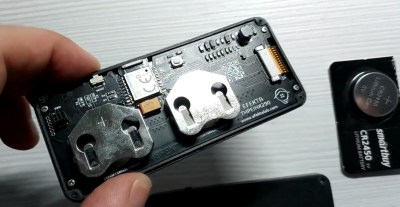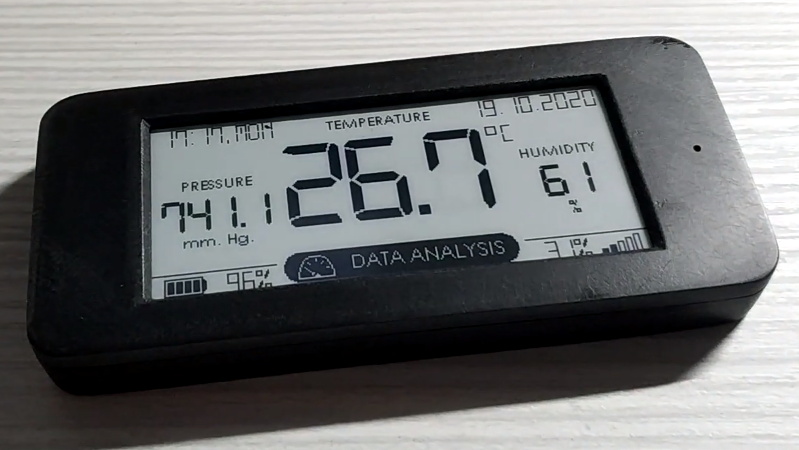We’re no strangers to DIY environmental monitors around these parts, in fact, it seems like that’s one of the most common projects hackers take on when confronted with the power of a modern Internet-connected microcontroller. But among such projects, this miniature nRF52-based weather station built by [Andrew Lamchenko] is among the most polished we’ve seen.
Externally, this looks as though it could easily be a commercial product. The graphical interface on the ePaper display is very well designed, delivering plenty of data while still looking attractive enough to hang in the kitchen. The enclosure is 3D printed, but [Andrew] poured enough elbow grease into sanding and polishing the front that you might not realize it at first glance.
 Internally it uses the popular BME280 sensor to detect temperature, humidity, and barometric pressure, though the custom PCB is also compatible with the similar SI7021 and HTU21D sensors if you want to switch things up.
Internally it uses the popular BME280 sensor to detect temperature, humidity, and barometric pressure, though the custom PCB is also compatible with the similar SI7021 and HTU21D sensors if you want to switch things up.
That said, you really want the ability to measure pressure, as it allows the firmware to do its own basic weather forecasting. All the collected data is beamed out over Bluetooth Low Energy (BLE), where it can be collected by the open source MySensors IoT framework, but we imagine it wouldn’t take much work to integrate it into your home automation system of choice.
As excited as we might be about the prospect of repurposing things such as electronic shelf labels, we’re happy to see the prices for general purpose electronic paper screens finally dropping to the point where projects of this caliber are within the means of the hacker crowd.
















I have an idea how to make a Covid-19 tester. OK, not really Covid-19, but air quality tester with carious sensors such as occupancy sensors, IR, noise. To determine if the air and surround is potentially virus hazard.
Some theories believe people get sick with Covid-19 or flu when they share bad air for long period of time. Kinda like carbon monoxide poisoning. And not so much via surface or food.
Based on that, the sensors can be made to measure enviroment quality and alert people.
Indeed I’ve read about environmental data (co2 level) used as a *proxy* for atmospheric viral density but for sure not considered a causal agent of an infection.
It’s not the bad air that is the problem, it’s that the air gets filled with aerosols – micro droplets – containing virus. The longer you stay in the droplet filled air, the more you have inhaled air with other people’s aerosols in it. And as we know, how sick you get from cov19 scales with the amount of virus you get into your body.
Opening a window and airing out will of course exchange the bad (CO2-rich) air and replace it with fresh air, but it will also exchange the moisture and aerosols for drier, virus free air
Measure air circulation, air in and out of a room. Good circulation means almost all aerosols emitted by humans in the room is exhausted outside. Not effective if someone coughs on your face.
and blast the room with UV lights if its unoccupied by humans.
Always wondered why NRF51/52 don’t get as much love as AVR or ESP32 or STM32?
I barely see NRF52 projects on the internet even though they’re pretty good at saving power
Because they seem pretty expensive and there doesn’t seem to be too many hacker friendly boards available.
The NRF52840 supports three protocols (BLE, OpenThread, and the proprietary Nordic protocol used by the NRF24L01+). I think this build uses the Nordic protocol, not BLE.
“All the collected data is beamed out over Bluetooth Low Energy (BLE), where it can be collected by the open source MySensors IoT framework, but we imagine it wouldn’t take much work to integrate it into your home automation system of choice.”